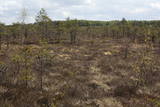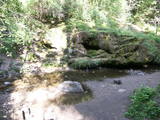| Nr | Nosaukums | Apraksts |
|---|---|---|
|
Piemiņas vieta 1. pasaules kara upuriem Klapkalnciema – Tukuma ceļa malā. |
||
|
Maza saimniecība ar īpašu dzīvesstilu Saaremaa, kas nodarbojas ar ārstniecības un garšaugu audzēšanu, ražošanu, pārstrādi un tirdzniecību. Ciemiņi var pastaigāties dārzā, paši lasīt augus un piedalīties mācību darbnīcās. |
||
|
3 km dienvidos no Jūrkalnes centra, pie vecā (grantētā) Liepājas – Jūrkalnes ceļa atrodas bijušās Feliksbergas trīsgadīgās jūrskolas (1871. - 1902. g.) vieta. Tā kā no ēkas nekas nav saglabājies, tās vieta iezīmēta ar tēstu ozola laivu un diviem koka stabiem, kuros ir izgrieztas senās zvejnieku īpašumu zīmes. |
||
|
Dzelzceļa vagons uzstādīts un veltīts uz Sibīrijas plašumiem deportētajiem 2916 nevainīgajiem Skrundas un apkaimes iedzīvotājiem, kurus lopu vagonos aizveda austrumu virzienā. Atrodas Stacijas ielā 1 pie Skrundas dzelzceļa stacijas. |
||
|
Smilšakmens iežos veidojusies ala ar vairākām arkām, pīlāriem un nišām. Liepas Lielās Ellītes alas (Ellīte, Velna ceplis, Velna krāsns, Vella ala, Liepmuižas ala, Liepas ala) kopgarums ir nedaudz vairāk par 20 m, tās griestu augstums sasniedz 3,5 m, bet platums 5 m. No alas izplūst spēcīgs avots. Domājams, ka tā sākusi veidoties jau pirms 7000 gadu. Ala daudz postīta, 20. gs. sākumā no tās raktas arī baltās smiltis. Lielā Ellīte ir sena kulta vieta. Mūsdienās vieta labiekārtota, izveidota atbilstošs labiekārtojums. |
||
|
Mājīgs restorāns, kura pavāri iedvesmojas no vietējās augu un dzīvnieku valsts, piedāvājot aizmirstas garšas jebkurā gadalaikā. Goda vietā ir gan vietējo, gan pasaules labāko meistaru produkti. Sezonu dažādo garšu un vīna brīnišķīgais salikums padara Umb Roht par restorānu, kas piedāvā dažādus garšu baudījumus. |
||
|
Saimniecība nodarbojas ar kaņepju audzēšanu un produktu izstrādāšanu vecajā Aizputes Pilsmuižas krogā, kas atrodas blakus Aizputes Livonijas ordeņa pilsdrupām. |
||
|
Teritorija veidota g.k. parastās purvmirtes un dažādu putnu sugu aizsardzībai. Kā interesants ir jāmin fakts, ka parastā purvmirte jeb balzamkārkls ietilpst Rīgas melnā balzama garšas buķetē. Brienamais purvs ir grūti atrodama un pieejama teritorija un kā tūrisma objekts apskatei nepiemērots.
|
||
|
Tālākais Hiiumaa salas ziemeļu punkts. Igaunijas augstākā čuguna bāka (1873. – 1875. g.) un piemineklis kuģa „Estonia” bojā gājušo piemiņai. |
||
|
Laipu taka, kas izved cauri augstā tipa purvam, kura vidū iegūlis Teirumnīku purva ezers. Tā krastā atrodas labiekārtota atpūtas vieta. Izejas punktā var atgriezties pa meža ceļu. Ietilpst Lubāna mitrāja teritorijā. |
||
|
Meklējams ~ 4 km pirms Apriķiem (ir norāde) - Ģibortu kapos. Te atdusas Neredzīgais Indriķis (1783. – 1828.) - latvietis, kas publicēja pirmo dzejoļu krājumu (1806. g.) latviešu valodā. Jāpiebilst, ka Indriķis bijis akls kopš piecu gadu vecuma un nebija gājis skolā. Viņa dzeju pierakstīja un minētajā gadā izdeva Apriķu draudzes mācītājs K. G. Elverfelds. Kapos uzstādīts piemiņas akmens (1935. g.) un tēlnieka Viļņa Titāna veidots “Austras koks” ar uzrakstu Braila rakstā. |
||
|
This tour leads to the popular seaside resort towns in Lithuania and Latvia, from Nida on the Curonian Spit to Jūrmala on the Gulf of Riga. The first stage of the route runs through the Curonian Spit to the city of Klaipėda with its symbol – the wooden sailing ship – and its old town resembling German towns in terms of architecture. You will then visit the Lithuanian summer beach capital Palanga with some of its top sights being the Botanical Park, the Amber Museum, the pedestrian street of J. Basanavičius and the Sea Pier. Next, the route will take you to the former fishermen village of Šventoji, now a resort town, near which the Žemaičių alkas (Samogitian Sanctuary) is located – an ancient pagan sanctuary. After crossing the border of Lithuania/Latvia you will reach Liepāja – known as the windiest city in Latvia. Should you be interested in military heritage, you will find that in the former military port of Karosta. The tour continues to reach Ventspils, another seaside city. Here, you can go on a voyage on a small vessel on the river Venta river and out to the sea, walk along the riverside, go for a ride on the narrow-gauge train called “Mazbānītis”, marvel at greenery in the form of clocks made of flowers, spot the iconic cows of Ventspils – multiple sculptures scattered around the city streets. At the end of the tour, you will drive to Jūrmala and walk on the Baltic Coastal Hiking Route through the longest Latvian resort cities boasting with its widest sandy beaches. |
||
|
Litorīnas jūras laikā (pirms ~ 6000 gadiem) Saleveres Salumegi kalns bija sala, bet mūsdienās tas kā izteikta kāple (īpaši - ziemeļu pusē) paceļas virs Piejūras līdzenuma. Salumegi ziemeļu pusē slejas 4 - 5 metrus augsts kaļķakmens atsegums – silūra perioda (> 400 mlj. gadu) koraļļu rifa paliekas, kuru noskalojuši Litorīnas jūras viļņi. Atseguma piekājē izplūst Acu avots, kam piedēvē dziednieciskas īpašības. Salumegi apskates nolūkos izveidota lokveida taka (1,5 km). No kalna augšas paveras labs skats uz Matsalu līci. Šeit atradies arī sens pilskalns. |
||
|
Raunas Staburags pēc Daugavas Staburaga appludināšanas šobrīd ir Latvijā raksturīgākais un izteiktākais šūnakmens veidojums, kas ir ~ 8000 gadus vecs un turpina veidoties arī mūsdienās - uz sūnām u.c. augiem izgulsnējoties avotkaļķiem. Raunas Staburags minēts kā vienīgā Alpu kreimules atradnes vieta, taču pēdējo 15 gadu laikā minētā suga nav konstatēta. Domājams, ka iemesls tam ir Staburaga apmeklētāju intensīvais nomīdījums. Avoti, kas veido avotkaļķus ir ES nozīmes prioritāras aizsardzības biotops. Tā kā Raunas Staburags šobrīd ir tā apmeklētāju nobrādāšanas un citu nedraudzīgu rīcību ziņā viens no visvairāk postītiem un apdraudētākajiem Latvijas dabas objektiem, skatīsimies to tikai no pretējā krasta un izbaudīsim "ar acīm" un fotoaparāta palīdzību!
|
||
|
Atrodas blakus Vecpiebalgas kultūras namam. Pieminekļa arhitekte ir A. Skujiņa, tēlniece M. Eņģele. |
||
|
Vieta Tartu centrā, kur var nobaudīt nelielas un vieglās fish & chips tipa maltītes, kas tapušas no Peipusa ezera apkārtnes produktiem. Nelielajā veikaliņā apvienotas Peipusa apkārtnes ēdināšanas tradīcijas ar moderno virtuvi, pie tam tiek izmantoti tikai vislabākie vietējie produkti. Milzīgus panākumus jau guvis no zandarta filejas gatavotais fish & chips, sulīgais burgers, kā arī vraps jeb tītenis. |
||
|
Parka teritorija ietver Lietuvas lielākās upes – Nemunas ielejas daļu starp Seredžius un Geldaudišķis ciemiem ar ļoti ainaviskiem skatiem uz tās krastos esošajiem pilskalniem, viduslaiku pilīm, muižām u.c.
|
||
|
Piemājas saimniecība nodarbojas ar augļkopību un biškopību! |
||
|
Zemnieku saimniecība "Indrāni" ir bioloģiska lauksaimniecība - ražotne. Vienīgais uzņēmums Latvijā, kas ražo bioloģiski sertificētas želejas konfektes, turklāt ar interesantām garšām, kā, piemēram, rupjmaizes, sarkanā āboliņa, kumelīšu, liepziedu, alus u.c. Tāpat iespējams nobaudīt arī citus saimniecībā saražotus lauku labumus un našķus, piemēram, sīrupus, ievārījumus un tējas. Nakšņošanai tiek piedāvāta brīvdienu māja ar pirti un telšu vietas. Blakus mājai atrodas dīķis ar peldvietu un laipām. Iespēja makšķerēt un vizināties ar laivu. Netālu ir Amatas upe. Saimnieki uzņem tūristu grupas ekskursijām, tāpat apskatāma senlietu kolekcija. |
||
|
Pie Lielauces muižas sākas laipu taka, kas pa purvaino (pārejas tipa purvs) Lielauces ezera krastu aizved līdz laivu novietnei pie ezera atklātās daļas. Var nomāt laivu un makšķerēt, jo zivju krājumi tiek regulāri atjaunoti. Atrodas Vīķu purva dabas liegumā. |
||























